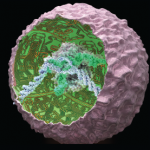 ACR Convergence 2020—On Nov. 8, 2020, Farshid Guilak, PhD, professor of orthopedic surgery at Washington University, St. Louis, Mo., and Shriners Hospitals for Children—St. Louis, gave the Oscar S. Gluck, MD, Memorial Lecture, describing his program’s multi-disciplinary approach to the treatment of arthritis.
ACR Convergence 2020—On Nov. 8, 2020, Farshid Guilak, PhD, professor of orthopedic surgery at Washington University, St. Louis, Mo., and Shriners Hospitals for Children—St. Louis, gave the Oscar S. Gluck, MD, Memorial Lecture, describing his program’s multi-disciplinary approach to the treatment of arthritis.
Dr. Guilak began by describing osteoarthritis (OA) and rheumatoid arthritis (RA) as two different diseases sharing a common pathway of inflammation. His laboratory focuses on combining tissue engineering and stem cells to create a treatment for arthritis that can, at minimum, delay joint replacement.
At its core, regenerative medicine uses stem cells to regenerates cells, tissues and organs to restore function. Stem cell therapy is the injection of stem cells into the body to treat disease, and tissue engineering combines cells, biomaterials and molecules to regenerate tissues and organs. Thus, it requires the creation of scaffolds of biocompatible materials that support tissue regeneration. These scaffolds can be made of soft gels with high-water content, which can be beneficial, but also result in a weak scaffold, making them unsuitable for withstanding joint loading.
Instead of gels, Dr. Guilak’s laboratory creates composite scaffolds of biocompatible fibers woven in three orthogonal directions (3D). The fibers can be woven tightly or loosely, and after the scaffold is created, they can be infiltrated with stem cells. These stem cells are then converted to cartilage or bone-producing cells. Over time, the biocompatible fibers are resorbed by the body. The result is a bioartificial cartilage with the properties of normal cartilage.
Dr. Guilak and colleagues use magnetic resonance imaging (MRI) or computed tomography (CT) to image patient joints and create anatomically shaped scaffolds that can be used for total joint resurfacing. The images can be used to create a computer aided design (CAD) model, allowing the virtual construction of a molded scaffold. The patient then undergoes liposuction, and stem cells are separated from the fat in the recovered tissue. The combination of the stem cells with the scaffold can create a bioartificial joint replacement.
These custom-designed stem cells have the potential to provide auto-regulated drug delivery & enhanced tissue repair, thereby revolutionizing the treatment of arthritis.
Inflammation
In patients with arthritis, inflammation persists even after the joints are resurfaced. Unfortunately, stem cells are exquisitely sensitive to this inflammation. Although biologic therapies may successfully treat autoimmune diseases, they are only partially successful at treating episodic disease flares seen in RA. Thus, Dr. Guilak and colleagues asked the question: Is it possible to repair tissue and resolve inflammation?
Dr. Guilak’s laboratory first approached this question by using drug-eluting fibers to engineer a system for long-term delivery of anti-rheumatic drugs. As they designed their system, they met the challenges of high concentrations, long-term delivery and dynamic response. As they sought to deliver a therapeutic molecule in a manner that would meet these challenges, they realized the answer required them to pivot to deliver a gene instead of a protein.
Their new solution packaged the gene coding for an inhibitor of the interleukin (IL) 1 receptor (IL-1 receptor antagonist or IL-1Ra) behind a doxycycline (dox) inducible promoter and placed it inside an inactivated lentivirus, which they used to coat the scaffold. The lentivirus remained attached to the scaffold and did not circulate through the body. Thus, the team was able to deliver an anti-rheumatic drug (anakinra) locally via engineered cartilage. According to Dr. Guilak, this approach provides a foundation for using total biological cartilage resurfacing to treat end-stage OA—an approach that may be particularly useful for young patients who currently have few therapeutic options.1
Disease Flares
Dr. Guilak then posed the question: Is it possible to program intelligence into cells so they can autoregulate the gene expression? Although the dox-inducible promoter made it possible to turn the IL-1Ra gene on or off like a faucet, it was difficult to know when to turn the gene on and off to stop inflammation when a flare occurs in the joint. So the laboratory strove to create designer smart cells capable of delivering biologics in an auto-regulated manner when they sense inflammation. To accomplish this, researchers identified a cell that normally had an inflammatory response and hijacked its pathway.
Dr. Guilak explained the process by asking the audience to imagine a cell as a simple iPhone, which contains short snippets of code. The researchers cut out that code and inserted it into stem cells using the CRISPR/Cas9 system. Thus, they created a synthetic gene circuit, so when the resulting smart cell sees tumor necrosis factor (TNF), it responds by synthesizing a TNF inhibitor. These smart cells can respond rapidly in vivo, allowing for time- and dose-dependent dynamics. In this way, Dr. Guilak’s laboratory customized the intrinsic cellular signaling pathways in stem cells, thereby, opening the possibility of safer and more effective therapeutic approaches for a wide variety of diseases.2
Such smart cells, when integrated onto scaffolds, can form smart implants that combine the genome and epigenome to create an artificial circuit that responds to a pre-identified stimulus. The result is a combination of gene editing, synthetic biology and tissue engineering to create designer cells that have prescribed cell‐surface molecules and receptors, as well as synthetic gene circuits.
These custom-designed stem cells have the potential to provide auto-regulated drug delivery and enhanced tissue repair, thereby revolutionizing the treatment of arthritis.3
Lara C. Pullen, PhD, is a medical writer based in the Chicago area.
References
- FT Moutos, KA Glass, SA Compton, et al. Anatomically shaped tissue-engineered cartilage with tunable and inducible anticytokine delivery for biological joint resurfacing. PNAS. 2016 Aug 2;113(31):E4513–E4522.
- JM Brunger, A Zutshi, VP Willard, et al. Genome engineering of stem cells for autonomously regulated, closed-loop delivery of biologic drugs. Stem Cell Rep. 2017 May 9;8(5):1202–1213.
- F Guilak, L Pferdehirt, AK Ross, et al. Designer stem cells: Genome engineering and the next generation of cell‐based therapies. J Orthop Res. 2019 Jun;37(6):1287–1293.

